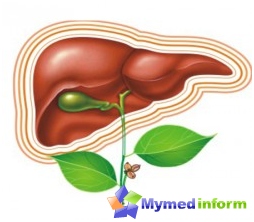So, chronic hepatitis call a disease, which is characterized by inflammation and necrosis of the hepatic tissue, which is continuing for six months and more. In the easiest cases, the disease usually does not progress or, if progresses, then quite slowly. In severe cases, the disease can lead to a gradual sealing of the connective tissue of the liver and development cirrhosis of the liver.
Causes

To the main reasons for the development of chronic hepatitis include the transferred hepatitis B, Hepatitis C, Autimmune hepatitis. And most often this is due to the inadequate treatment of acute viral hepatitis C. So, often, many patients in a medical record have no information that man suffered acute hepatitis. Therefore, the doctor may not always establish the correct diagnosis in a timely manner. Moreover, the first sign of the development of the chronic form of hepatitis becomes an increase in aminotransferase, which, as a rule, occurs without any symptoms. This makes it more difficult to diagnose the disease.
In addition, provoked the disease of the liver can receive some drugs. Thus, chronic hepatitis can cause tetracycline antibiotics, hypotensive drugs, sedatives, narcotic drugs, anti-tuberculosis agents and cytostatic agents. It is often the reason for the formation of chronic hepatitis is the prolonged impact of various toxic substances. Such substances, for example, are alcohol and benzene.
Symptoms

If there is a suspicion of chronic liver damage, then the doctor usually first conducts an examination of the abdominal cavity with tacking. In particular, the doctor determines the size of the liver and spleen. In addition, a patient survey is conducted. At the same time, the doctor usually asks what drugs accepted the patient, and also specifies the presence of other factors that can provoke the beginning of the disease. After that, assays are usually assigned to determine the presence of viral hepatitis. In addition, it is assigned a detailed blood chemistry, The values of the hepatic function are determined, and analysis on autoantibodies is also carried out. The study of functional hepatic tests includes the determination of the level of AST and Alt enzymes, the determination of alkaline phosphatase, as well as the definition of bilirubin. The most characteristic feature of the presence of chronic hepatitis in the patient is to increase the level of aminotransferase. Although, if the course of the disease is stable, then the levels of aminotransferase may be normal.
As for alkaline phosphatase, it, as a rule, remains within the normal range or may be slightly elevated. The value of the bilirubin is usually also within the normal range, but this applies only to non-heightened cases of the disease.
In general, it should be noted that changes in such laboratory tests are not something categorical. The fact is that the deviation of these indicators may be associated with other pathologies. In particular, such diseases include recurrence of acute viral hepatitis, alcoholic disease and primary biliary cirrhosis. Liver biopsy is performed to assess the severity of the state. Also be sure to patients prescribe an abdominal ultrasound. And if the doctor finds the necessary, computer tomography is carried out.
In some cases, chronic hepatitis can only manifest itself in the form of a slight necrosis of hepatic cells or in the form of inflammatory cell infiltration, which usually occurs in the field of portal veins. It is for such cases that the liver biopsy should be carried out. The fact is that clinically such cases are rarely manifested and usually do not develop to the liver cirrhosis.
In order to assess the severity of the processes, the serum albumin albumin is conducted. So, the low level of albumin usually indicates hepatic failure. Sometimes a study of the cryoglobulin level is assigned, as well as determining the value of the rheumatoid factor. This is especially true in chronic hepatitis C.
Treatment

The primary task of treatment is to ensure the remission of the disease. At the same time, the treatment of chronic hepatitis usually depends on its option. Thus, when treating viral hepatitis, glucocorticosteroids, alpha interferons, cytostatics are used. In this case, symptomatic therapy is also often used.
At autoimmune hepatitis, cytostatic and hormonal therapy is usually assigned. If necessary, liver transplantation is carried out.
For the treatment of toxic hepatitis, first of all, the impact of the toxic factor on the patient's liver. It is necessary, first of all, so that the liver herself was able to restore his full job. In addition to stopping the impact of toxins, drugs of group of hepatoprotectors are also prescribed. The latter are commonly used to increase the resistance of the liver to the effects of pathogenic factors and in order to strengthen liver regeneration processes. The best of these are complex drugs that consist of amino acids, vitamins, as well as from plant extracts, which complement the composition of the drug. In addition, it is not necessary to re-take medicines that have toxic impact on the liver. It must be remembered that hepatitis is a very serious disease. Therefore, in order for the treatment to bring a good result, it is necessary to strictly observe all prescriptions of the doctor.
Special importance in the treatment of chronic hepatitis has food. In this case, the patient is prescribed for a diet No. 5. This system of nutrition implies an exception to smoked, alcohol, fried, salt, refractory fats from its diet;. The rest of the fats should be about 35% of the human diet. They are useful, t. To. are choleretic means. In this case, animal fats are recommended to replace on vegetable.
In general, the success of the treatment of the disease depends on the set of factors. In particular, it depends on the prescription of the disease, the individual characteristics of the human body and the presence of concomitant diseases.









